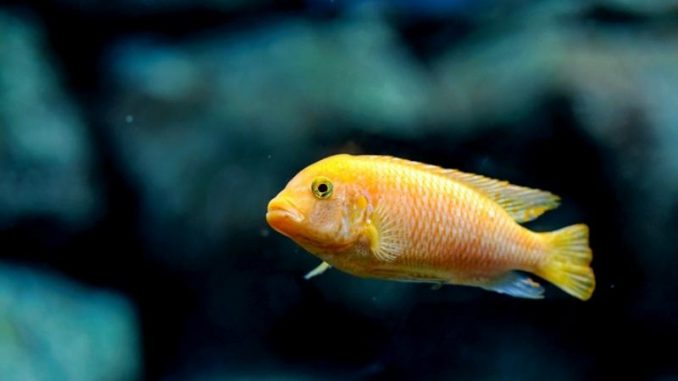
The red zebra cichlid is a freshwater fish of the Cichlidae family. These cichlids are found in a variety of color morphs, including blue — not to be confused with the blue zebra cichlid (Maylandia callainos).
Red zebra cichlids are popular among aquarists due to the fish’s bold personalities and bright colors. However, like many African cichlids, these fish are known for their territorial aggression and are incompatible with some tank mates.
TABLE OF CONTENTS
- Red Zebra Cichlid Facts & Overview
- Appearance & Behavior
- Red Zebra Cichlid Tank Requirements
- Common Red Zebra Cichlid Health Issues and Diseases
- Red Zebra Cichlid Tank Mates
- Red Zebra Cichlid Diet and Feeding
- Breeding the Red Zebra Cichlid
- Should You Get a Red Zebra Cichlid for Your Aquarium?
- Red Zebra Cichlid FAQs
Red Zebra Cichlid Facts & Overview
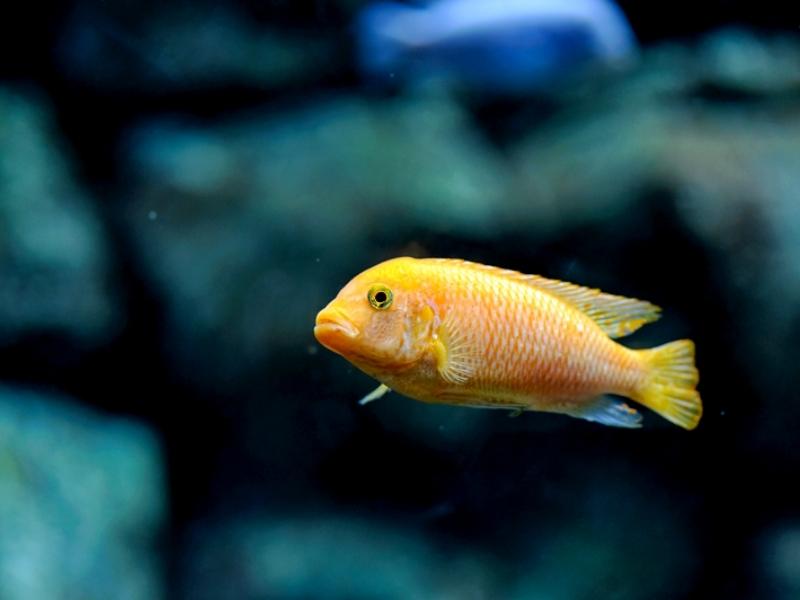
| Scientific name: | Maylandia estherae |
| Common names | Red zebra cichlid, Esther Grant's zebra, red zebra mbuna |
| Distribution: | Lake Malawi, East Africa |
| Size: | 4–5 inches |
| Life expectancy: | 8–10 years |
| Color: | Red, beige, brown, blue, yellow, pink, mottled |
| Diet: | Omnivore |
| Temperament: | Semi-aggressive |
| Minimum tank size: | 55 gallons |
| Temperature: | 72–82°F (22–28°C) |
| pH: | 7.5–8.6 |
| Hardness: | 6–15 dGH |
| Care level: | Easy |
| Breeding: | Mouthbrooder |
Origin
The red zebra cichlid originates in Lake Malawi, a large East African lake that spans across Malawi, Tanzania, and Mozambique. The fish’s natural habitat is warm, slow-moving freshwater, with a sandy, rocky substrate that offers plenty of hiding spots. The red zebra cichlid is common in the wild and is thought to be one of more than 1,000 cichlid species in Lake Malawi.
Adult Size & Lifespan
In the wild and in captivity, a full-grown red zebra cichlid is 4–5 inches long. Males are about 1 inch longer than females.
The average lifespan of a red zebra cichlid is 8–10 years. With the right care, some fish in captivity live up to 12 years.
Availability
Red zebra cichlids are easy to find in pet stores and online. The fish are affordable, costing about $9 for a small fish and up to $24 for a large fish. Buying at least four red zebra cichlids for your aquarium is recommended.
Reputable online stores selling red zebra cichlids are:
Appearance & Behavior
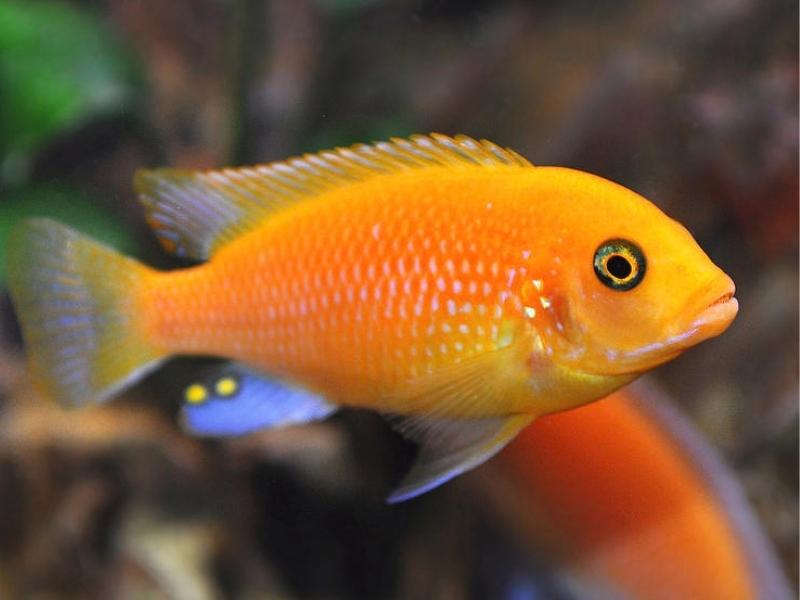
Red zebra cichlids are medium-sized, semi-aggressive fish found in several bright colors.
Colors, Patterns, Fins, and Sex Differences
Red zebra cichlids have muscular, torpedo-shaped bodies and are stockier than other zebra cichlids. The fish have small, compact fins and triangular tails.
The red zebra cichlid has a misleading name — many red zebra cichlids aren’t red or stripy. Common red zebra cichlid colors are:
- Red
- Beige
- Brown
- Blue
- Yellow
- Pink
- Mottled
- Albino (rare)
Typically, females are yellow, beige or brown, while males are bright blue. Males become bolder in color during breeding season when they’re trying to attract females. Females are rounder than males, and males have larger and more numerous egg spots on their anal fins than females.
Stressed or diseased red zebra cichlids become paler in color than normal.
Typical Behavior
The red zebra cichlid is known for its semi-aggressive nature. The fish gets along well with similarly-sized fish but has natural territorial instincts, and may bully and harass its smaller tank mates to death if it doesn’t have enough space.
Red zebra cichlids are slow swimmers that spend most of their time drifting along the bottom of the tank, exploring caves, and searching for food. The fish are most active during the day and sleep in caves or on the substrate for up to 12 hours overnight.
Red Zebra Cichlid Tank Requirements
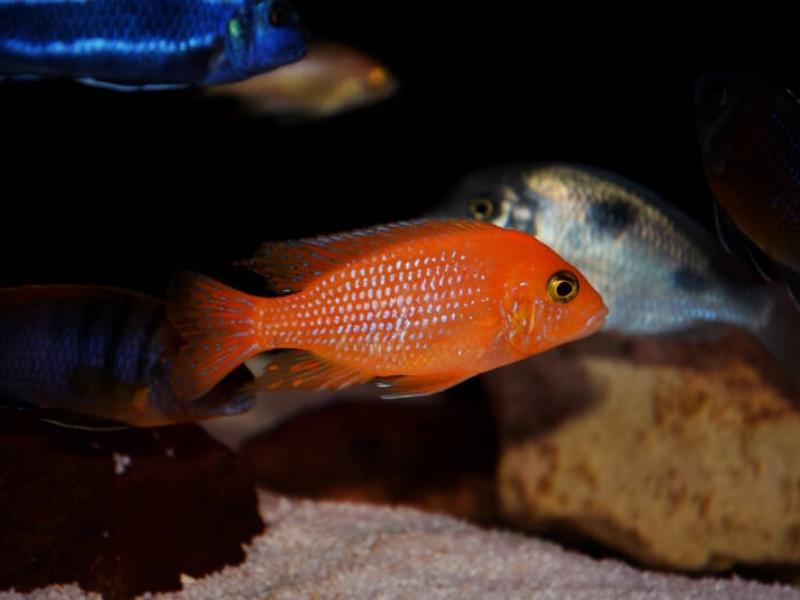
Caring for the red zebra cichlid is easy as long as you maintain optimal water conditions and provide enough space for the fish to claim their own territories. The fish need a warm freshwater habitat that replicates Lake Malawi’s waters.
Habitat and Tank Setup
The red zebra cichlid’s natural habitat is the sandy, rocky waters of Lake Malawi. Replicate this habitat in captivity with suitable tank conditions and the right water parameters.
Red zebra cichlids spend a lot of time at the bottom of the tank and are known to dig in the substrate and rearrange decor. Use a smooth pebble or sandy substrate to prevent damage to the fish’s body.
Provide plenty of rock structures in the tank, including tunnels, rock piles, and caves, to give the fish hiding places and reduce territorial behavior.
Red zebra cichlids like to dig up plants, so plants that root into the substrate aren’t suitable for the tank. The best plants are those that can be grown on rocks and caves, like anubias and java moss.
Tank Conditions
Ideal tank conditions for a red zebra cichlid are:
| Water type | Alkaline, slow-moving freshwater |
| Tank size | Minimum 55 gallons for a small group of four to five fish |
| Water temperature | 72–82°F |
| Substrate | Soft sand or smooth pebbles |
| Tank setup | Rocks, caves, tunnels, plants |
| Acidity | 7.5–8.6 pH |
| Water hardness | 6–15 dGH |
| Filter | Yes, a canister filter will keep the water clean without producing too much current |
| Bubbler | Not essential |
| Lighting | Standard fluorescent or LED aquarium lighting |
| Water heater | Yes, to keep the water warm |
Red zebra cichlids are hardy, but they still require consistent water parameters to survive. A good filter and water heater are essential for a thriving community of red zebra cichlids.
Common Red Zebra Cichlid Health Issues and Diseases
Red zebra cichlids are prone to several diseases that are common amongst freshwater fish. Maintaining clean, warm water conditions should prevent most of these diseases.
Health Issue | Symptoms | Suggested Action |
| Malawi bloat | Loss of appetite, abdominal swelling, scales that poke away from the body, discolored feces, rapid breathing | Perform a large water change and treat the water with metronidazole (an antibiotic) or feed the fish foods containing metronidazole |
| Swim bladder disease | Floating to the top or sinking to the bottom of the tank, struggling to stay upright, distended belly, curved back | Allow the fish to fast for three days, speak to your veterinarian about antibiotics, and add 1/8 teaspoon of Epsom salt per 5 gallons of water |
| Tuberculosis | Lethargy, frayed fins, or no symptoms at all. Random deaths with no links to other diseases | No treatment, only supportive care. Reduce the risk of infection by properly quarantining new fish and plants before adding them to the tank |
Red Zebra Cichlid Tank Mates
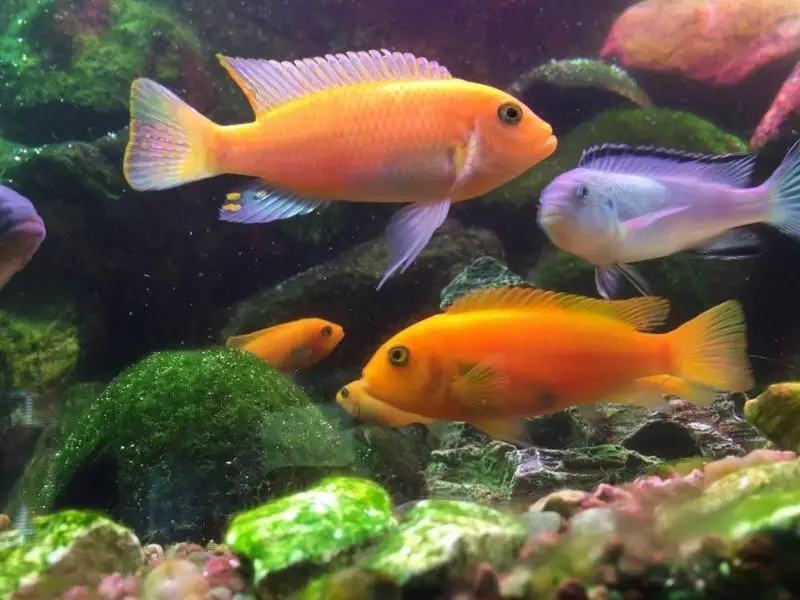
Ideally, red zebra cichlids should be housed in a single-species tank due to their territorial nature. However, the fish are compatible with other confident, medium-sized fish from Lake Malawi. Don’t house red zebra cichlids with small fish or invertebrates that could be easily bullied by a semi-aggressive, territorial fish species.
Good tank mates for red zebra cichlids are:
- Other red zebra cichlids (groups of four or more, with one male for every three females, will reduce the risk of conflict)
- Jewel cichlids
- Malawi squeakers
- Electric yellow cichlids
- Blue-gray mbunas
- Powder-blue cichlids
- Bristlenose plecos
Red Zebra Cichlid Diet and Feeding
In the wild, the red zebra cichlid eats a combination of plant and animal matter, including algae, small insects, and invertebrates.
Replicate this diet in captivity by feeding your fish a balanced diet of microworms, brine shrimp, algae wafers, and spirulina pellets. Blanched spinach and lettuce are good supplementary foods for this cichlid species.
Feed red zebra cichlids a pinch of food three or four times per day. Only provide enough food that can be eaten within 30 seconds — red zebra cichlids are greedy fish that will overeat if given the opportunity.
Ensure the fish follow a largely herbivorous diet. Too much protein can result in health problems and obesity in these cichlids.
Breeding the Red Zebra Cichlid
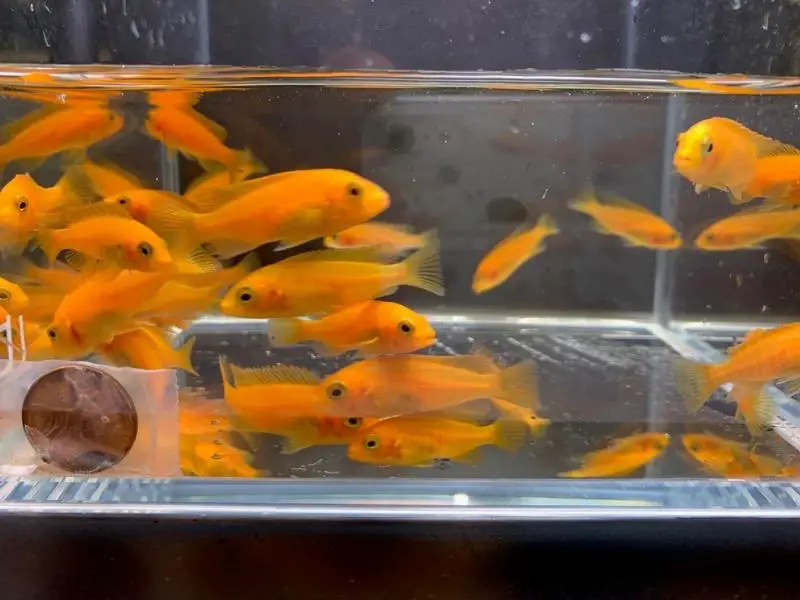
Breeding red zebra cichlids in captivity are easy, and the fish reach sexual maturity when they’re about three years old, or 3 inches long.
To successfully breed red zebra cichlids, follow these steps:
- Ensure there is one male to every three females in the home tank. A separate breeding tank isn’t necessary, and you don’t need to adjust the water parameters — the fish will breed naturally
- Wait for a male to prepare a nest in a cave, then attract the females by shimmying and displaying its vibrant colors. An interested female will follow the male into the cave and lay eggs on a flat rock. After laying up to 60 eggs, the female will scoop the eggs into her mouth, and the male will release his sperm into the eggs
- Allow up to 20 days for the fry to hatch. The female will continue to carry the eggs and fry in her mouth for up to one month before allowing the fry to swim freely in the tank
- Feed the fry baby brine shrimp or daphnia once they are free-swimming
- Move the fry into separate tanks once they reach six months old
Should You Get a Red Zebra Cichlid for Your Aquarium?
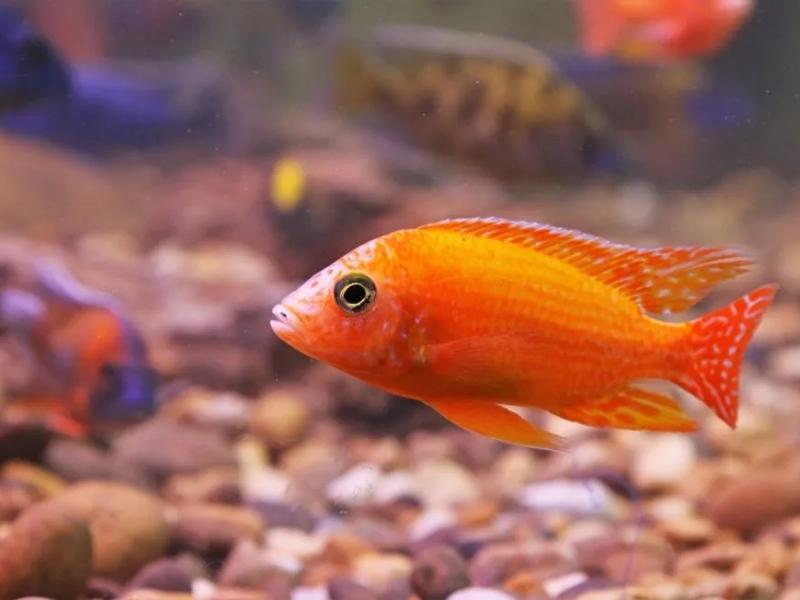
The red zebra cichlid is a confident, colorful fish that makes a great addition to a home aquarium. However, this fish isn’t suitable for all community tank setups.
Consider getting a red zebra cichlid if you plan to set up a single-species tank or your tank contains other compatible Lake Malawi fish species. Don’t get a red zebra cichlid if your tank is cramped or contains small, nervous fish that would be bullied by a territorial fish.
Despite their semi-aggressive personalities, red zebra cichlids are entertaining fish that are easy to care for in the right tank environment.
Red Zebra Cichlid FAQs
How Big Do Red Zebra Cichlids Get?
Red zebra cichlids get as big as 5 inches long. Full-grown males are about 1 inch longer than full-grown females. The fish are medium-sized African cichlids, like jewel cichlids and electric blue cichlids. A group of four or five red zebra cichlids should be housed in a minimum 55-gallon tank.
Are Red Zebra Cichlids Aggressive?
Red zebra cichlids are semi-aggressive due to their natural territorial instincts. The fish are most likely to behave aggressively if they’re housed in a cramped tank with too little space to claim separate territories. To reduce the red zebra cichlid’s aggressive nature, house the fish in a roomy tank with plenty of caves and hiding places, and ensure there are three females for every one male.
How Long Do Zebra Cichlids Live?
Zebra cichlids live for 8–10 years on average, depending on their quality of care. Some fish live up to 12 years in captivity when cared for well. To increase a red zebra cichlid’s lifespan, feed the fish a healthy omnivorous diet and ensure the water conditions are consistently clean.

Be the first to comment